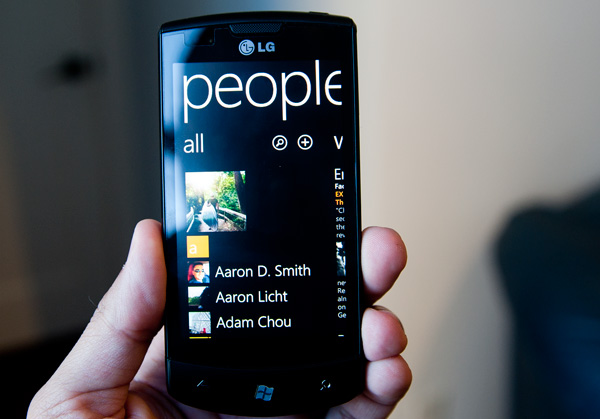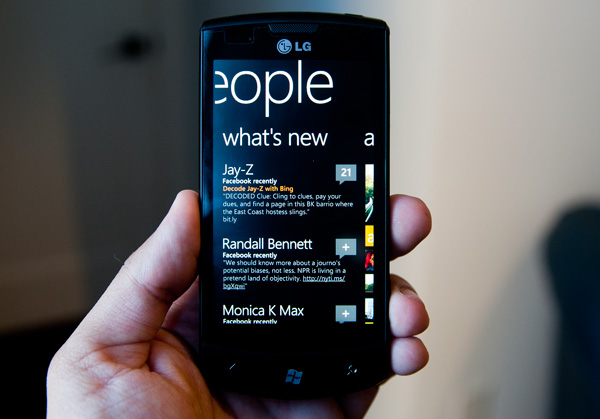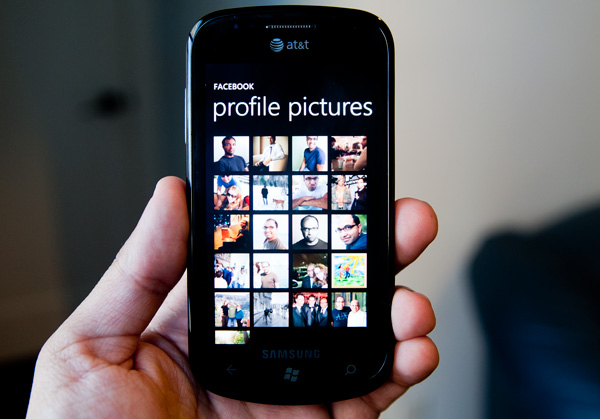The Windows Phone 7 Review
by Anand Lal Shimpi & Brian Klug on October 20, 2010 7:00 PM EST- Posted in
- Smartphones
- Windows Phone 7
- Microsoft
- Mobile
Facebook Integration
Windows Phone does the best job of Facebook integration I’ve seen of any smartphone platform.
Palm’s webOS was the first to seamlessly integrate Facebook into a modern day smartphone. Supply it with your Facebook credentials and you saw the entirety of your oversized friends list appear in your phone contacts. Email addresses, IM accounts, phone numbers and more were all automatically populated in your address book. If any of your Facebook friends changed their information, the information updated on its own on your phone. It was the wave of the future.
Spiritually, Microsoft picks up where Palm left off. You can do the same sort of blanket integration that you could with the Pre. Supply your Facebook login information and Microsoft syncs all of your contacts through the cloud. Unlike webOS however, Microsoft gives you an option to not sync all of your Facebook friends. You can choose to only sync those Facebook contacts who are already in your address book (from Google, Hotmail, Exchange or Yahoo).
Microsoft integrates Facebook in more places than just your address book however. Meet the People Hub.
People Hub
For all intents and purposes the People hub is the Facebook app for Windows Phone 7. If you’ve supplied your Facebook login, the default “what’s new” tab will serve as your news feed. It’s not the reduced load Top News feed you get from Facebook, but literally the most recent news from all of your Facebook friends and pages. You get 25 posts by default (non customizable) and there’s a get older posts button at the bottom of the page if you want to see more.
It’s not a total Facebook app replacement as you don’t get non-content updates. Items like who your friends have added to their friends list are absent from the feed. There is also no integration of friend request management. The Facebook integration is mostly for passive consumption with a couple of exceptions. You can view and add comments to posts as well as like posts, however you can’t see who has liked a post (just the number of likes for any given post).
Tapping on anyones name in the what’s new feed brings you to their contact page. You can view their “what’s new” feed and comment on their posts. You can also view their profile which will pull in data from both Facebook and your contacts (e.g. through Google or Live). Microsoft clearly (and cleanly) indicates what sources it is using to pull the profile information from under the contact’s name.
If you really like talking to/keeping tabs on/being creepy to a person, you can pin their profile to your Start screen for easy access.
From the profile tab you can write on their Facebook wall, send an email, make a phone call, send them a text message or even bring up their address on Bing maps.
All of these functions are super fast and seamlessly integrated into the experience. Quickly writing on someone’s wall without having to fire up a separate Facebook app couldn’t be faster. There’s literally a Write on wall screen that quickly appears when you select the option to. Sending an email or text message from the profile screen is a bit slower since you’re technically switching to another app, but it’s near instantaneous.
Here’s where the functionality of the back button really one-ups iOS multitasking. Let’s say I’m viewing a friend’s profile and I want to get directions to his house. I can click on his address on the profile page which will immediately fire up the Maps app. I can use Maps to quickly see where he lives (or eventually get directions) but now when I want to go back to his profile to send him a text message, there’s no double tapping or app selection - I just hit the back button and I’m back at his profile. Had I tried to get directions while at the Maps screen I would’ve tapped the back button twice (once to get out of directions and into the normal map and once again to go back to the profile) but it’s still a snappier process than manually switching between apps in iOS. The advantage is really limited to these types of scenarios however.
There’s still the need for a standalone Facebook app for more of the FB-specific features (gift giving, messaging, apps, chat, etc...), but the People hub gives you access to the most commonly used tasks. Update: A standalone Facebook app is now available for WP7.
While you can exclude Facebook friends who aren’t already in your address book from appearing in your address book, doing so will not keep those friends from appearing in your what’s new feed. The good news is that the what’s new feed will respect your Facebook news feed options. If you’ve removed someone’s updates from appearing in your Facebook news feed, their updates won’t appear in the what’s new tab on Windows Phone 7.
Today Facebook is front and center with Windows Phone, but it would be just as easy for Microsoft to extend the interface to support other social networks or status aggregators. Twitter obviously comes to mind and while Microsoft isn’t officially announcing anything yet, that’s clearly a target that we can expect to see pulled in at some point.
Aside from the news feed, there are two more tabs to the People hub: recent and all. The recent tab is actually a two-page tab that displays up to 8 tiles of people you’ve either recently communicated with or whose profiles you’ve viewed/stalked. The tiles are animated so you’ll see them alternate between a photo, photo + name, or just name.
This tab is effectively your favorites as there is no such functionality in the Phone app. You don’t get one touch dialing or emailing unfortunately, you’ll need one tap to select the contact and one more to choose your communication method.
The all tab is exactly what it sounds like - a list of all of your contacts. The topmost contact? A big link to your own profile of course, which you can use to provide status updates on your Facebook wall.
The search button will let you search through the all people tab. Results are narrowed down/highlighted as you type.
Tapping on any of the highlighted headers brings you to this screen, which you can use to jump to any other header in the list. I feel like the Android/iOS scrolling widget makes more sense but the Microsoft approach does work.
Facebook Photo Integration
What I was more impressed by was the Facebook integration in the Pictures hub. Your profile pictures and mobile uploads are both listed as albums when looking through all of your photos by date. Browsing photos you’ve synced, photos you’ve stored in the cloud and photos you’ve uploaded to Facebook is not only possible, but done sensibly. On top of all of that, there’s also a what’s new tab in the Pictures hub that just gives you a feed of all of the photos your Facebook friends have posted recently. It’s a great way to photo stalk if that’s what you ultimately end up doing on Facebook anyway.
While Palm used Facebook as a way to integrate contacts, other companies have since tried to pull status updates and photos from the service to populate your phone. Microsoft now joins the list of those who have tried, and while the integration isn’t perfect, it’s quite possibly the best attempt yet.














125 Comments
View All Comments
Shadowmaster625 - Friday, October 22, 2010 - link
It cant play avi files? What do you call a $500 device that cant play avi files? FAIL.beefnot - Friday, October 22, 2010 - link
I'm so sick of seeing "fail" in user comments. 99% of the time, it follows a point or points being made that wouldn't have swayed them to deem it worthy anyway. YAWN.mutatio - Friday, October 22, 2010 - link
I'm glad you guys found it to be as smooth and useful as you did. Based on what you described and the corresponding pictures, however, I'm having a hard time understanding something "just works" when the UI looks like a crap sandwich and almost makes my eyes bleed. "No, we don't use those oh-so-80's icons that graphically represent what the App does. We're much too posh for that, minimalist traffic signs for everything! Brilliant!" Maybe it'll be different with hands on, but it looks like MS went out of their way to try and make this thing look clever and almost abstract. Think myspace made into a smartphone, and if you're like me and think that myspace pages more often look like pop culture chewed up, swallowed, and thrown up onto a web page, then you get where I'm coming from. If that is the case when I get my hands on one of these, I can't see how MS can get any significant traction in the smartphone market. They might get some young emo hipsters who dig the abstract layout, but the appeal thus far of iOS and Android is the overall ease of use. My impression from your review, despite your reassurances, is that MS has again made a product much more complicated than it needs to be. I hope for MS' sake that is not the case when actually using the phone.MacGyver85 - Saturday, October 23, 2010 - link
You'll just have to try it to appreciate it I guess.I can understand people when they say the interface looks bland or overly simplistic based on "screenshots" of the UI. But when you see it in person it's so much better. Really.
Likewise with how you navigate around it. It's just so intuitive you don't for a second have to think how to do something. Every time someone asks me if what it's like I always respond that they'll have to use it themselves. And everyone that does loves it. Seriously :)
Dare I use it but what the hell: it just works!
DJJoeJoe - Saturday, October 23, 2010 - link
I don't think any OS at this point can grab a drastic number of market share like we see in the phone space obviously, or even the slightly slower moving browser space. Modern Operating Systems are so mature at this point that there is really little you can do, both Win7 and Snow Leopard were just small refinements to their previous versions.I think it's doubtful that even something as force-ably drastic as Chrome OS will do anything to the landscape either, even if Google bucketed down and really nailed it. Sadly the market share is ruled by the people going to costco and grabbing up a pre made pc, or large corps running xp, and I can't see something drastic being sold to either groups in the next handful of years.
tis all in the phones these days, and I wish I had a time machine so I could get the second wave of hopefully nicer wp7 handsets and maybe a good update to the os itself. Don't got the money to spend on a 'amazing start'.
Sabresiberian - Monday, October 25, 2010 - link
Looks to me like Vista's bad press helped Apple reach 9% market share, but that's as far as they've moved up. Win 7 is sweet and everyone knows it so Apple is no longer making headway.I don't want Microsoft execs to think that way though - like was written in the article, I think Microsoft performs better as an underdog, and if they think more in terms of being threatened by Apple or someone else then perhaps they'll be more inclined to put a shining example of what they can do out on the market.
Glad to see Microsoft did produce a product with some shine.
;)
dotroy - Thursday, October 28, 2010 - link
Windows 7 phone is good ...umm ..some things not as good ..but win7 phone is good, there are somethings done better by others OS but win 7 phone is good. I never felt like this before. This is a paid advertising. Anand is making good money.pete2s - Thursday, October 28, 2010 - link
Will Windows 7 Phone store apps on the ROM partition? If so, this severely limits the number and size of apps as well as their quality.Although Android is evolving past this limitation, Android, Blackberry and Palm phones store the OS and all apps on an encrypted partition referred to in the specs as the ROM. Usually, this ROM is 512MB. After the OS is installed, the phone has less than 300MB for apps.
Initially, I thought Windows 7 Phone would not store apps on the ROM because of its unified storage system that creates a single volume. If this were the case, however, there'd be no point in having a larger ROM because the ROM would only be holding the OS + the 60MB limit of pre-installed software. Some phones, like the Samsung Focus, do have larger ROMs though (1GB compared to 512MB). The only point of having a larger ROM would be to store more apps because apps are installed to the ROM.
If the above is true, Windows 7 Phone will be severely limited in app size and thus development.
drwho9437 - Monday, November 1, 2010 - link
"It’s almost as if Microsoft is taking Apple’s approach and simply letting everyone build iPhones."Exactly and it is genius, it means the cost margin will vanish and the experience will still be as the software people want, people won't think poorly of these phones just because of a few badly designed devices they used. Let's hope it works out.
owbert - Monday, November 1, 2010 - link
best review of win7 phone amongst others. great work!